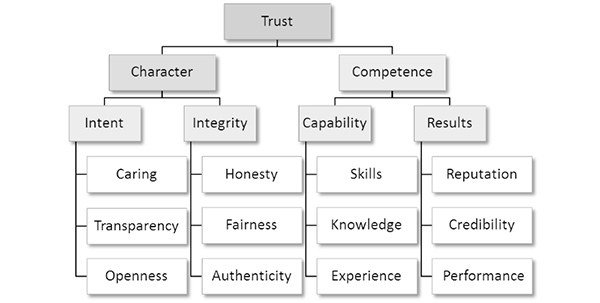Trust Us: We Have the Secret Formula to Building Trust With Others

Trust. It’s important, isn’t it? And like most important things, it doesn’t come easy. More often than not, building trust with other people involves thought, consideration, and elbow grease—not just a great first impression.
Richard Barrett, Chairman and Founder of Barrett Values Centre, shares a figure that goes beyond one or even two core qualities of being trustworthy. This graph, known as the Trust Matrix, intertwines a whopping 12 components needed to take relationships beyond surface-level interactions.

Seeing things laid out so plainly like this makes something smack-your-forehead-obvious: there are tons of similarities between a company gaining the trust of customers, and individuals gaining the trust of each other. In fact, the process and core elements are almost identical.
Say you’re taking on a more senior Ninja role. Building trust with the team below you technically is like selling something—yourself. Instead of looping the company’s values and rules on a mindless repeat that frames you a boss and not a leader, you need to prove you’re reliable and trustworthy. As the Matrix shows, your character and your confidence hold equal weight.
It might seem forced to consider yourself in this sort of context—nobody wants to come off like an overly pushy salesperson. Instead of imagining your leadership style like a cheesy brand that only pushes advertisements, think of yourself as one that shares true value.
When you’re in the position to pass your knowledge up and down the organization, pay attention to your delivery as closely as you do the information you’re sharing. You’ll see that “transparency” and “openness” both fall under “intent” for a reason. By intentionally adopting some of these qualities, the connections you have in the office will take on more depth—which is good for everyone.
To drive this point home, let’s explore how a few of the core elements relate to building trust with other people in both business and one-on-one relationships.
Transparency
Whether it’s a person or a brand you’re dealing with, there’s no denying that a “What you see is what you get” sort of attitude can be both refreshing and reassuring. Openness and honesty is usually enough to inspire at least a little bit of trust right off the bat.
If you immediately cringe at infomercial-worthy language like “Only $99.99 plus shipping and handling!”, you aren’t alone. This ploy exists to trick you—the business doesn’t seem forthcoming, and you’re instantly much less willing to take what they say at face value.
Here’s a great example: the food industry. A 2015 study found that transparency greatly increases customers’ trust in what they’re eating. “Transparency works,” said Charlie Arnot, CEO, The Center for Food Integrity. “We have statistical data to show that increasing transparency in farming, food production, and processing will increase consumer trust.”
Alright, so you probably aren’t peddling snacks when attempting to build trust with a colleague or acquaintance (although, hey, it might be a surefire way to gain some favor!). However, this transparency concept still rings true in personal relationships.
Nobody trusts those who say one thing and then do the opposite, or who appear to tailor their opinions based on who they’re speaking to. To be perceived as trustworthy in your own daily business, make sure that you’re always completely honest and open about your beliefs, your values, and your actions as they pertain to the goal.
Authenticity
In a similar vein as transparency—but falling under the umbrella of integrity rather than intent—there’s authenticity.
What does it mean to be authentic? To put it simply, it means being true to yourself. It means owning who you are, rather than attempting to masquerade as somebody else. This is undeniably important for businesses and people alike.
Plenty of authentic brands spring to mind—think Apple or Airbnb. Hobby Lobby is another that might not pop into your brain immediately, but is undeniably genuine and authentic in how they do business.
The company has made headlines for wanting to opt out of providing coverage for contraceptives, as it went against the corporation’s religious beliefs. All Hobby Lobby locations are closed on Sundays, and the craft chain refuses to open on Thanksgiving for eager holiday shoppers—so that employees can enjoy time spent with their families and loved ones.
Of course, Hobby Lobby’s strong views are enough to isolate the people who disagree. However, their authenticity attracts their tribe—the people who look at the brand and respect what they stand for. It’s not always a PR dream, but sticking with their guns has made them trustworthy.
The same is true for how you evoke authenticity in your personal interactions—especially at work. It won’t always be a frictionless endeavor, but being consistent in your leadership and message will take you much farther than being well-liked on the surface. That’s an important quality in people who not only deserve, but earn, trust.
Knowledge
Let’s say your toilet won’t stop running, so you call a plumber to come and fix it for you. The plumber shows up in a BMW with a briefcase and a three-piece suit and explains to you that—while he’s never actually fixed a toilet before—he’s a smart and experienced financial planner who feels confident that it can’t be any harder than choosing smart investments.
That would be weird, right? In order to trust someone to get a job done and get it done right, you first need to feel confident that they have the skills, experience, and relevant capabilities.
The same thing happens on an individual level. We want to head to that Excel whiz in the office to fix our spreadsheet problem, because we trust that he can handle it quickly and effectively. We ask the grammar aficionado to look through our presentation, because we trust that she’ll catch looming errors.
As marketing specialist Guy Kawasaki says, “Knowledge is great. Competence is great. But the combination of both encourages people to trust you and increases your powers of enchantment.”
It’s no wonder that competence is another one of the major elements of the Trust Matrix. Demonstrating that you have the necessary knowledge and expertise to have credibility on a certain topic makes you that much more deserving of trust.
Reputation
Finally, we get to that thing that often precedes you: your reputation.
Would you want to buy a car from a salesman who has a record of sending people home in total lemons? Do you want to confide in that colleague who’s known around your office as the resident gossip? Probably not—to all of the above.
While you may not have personally been burned, you wouldn’t trust them enough to roll the dice and take your chances. Their reputations have prevented you from investing your trust.
This is why it’s so important to put the work into fostering and maintaining positive reputations. For a business, you’d recognize that as providing quality customer service and being receptive to feedback.
For individuals, it means following through on your promises and meeting deadlines, refusing to make snarky comments behind anyone’s back, and, always doing your best to produce high-quality work.
Remember, your reputation has a huge impact on how trustworthy people perceive you to be. Luckily, it’s something that you have quite a bit of control over.
Trust is a valuable ingredient in any relationship—one that helps careers and keeps customers, colleagues, and clients satisfied. Whether it’s your personal brand or your business’s brand, the fundamentals are always the same—and there’s a lot to be learned from the ones doing it right.
How do you go about establishing and maintaining trust? Which components of the trust matrix do you think are most important?
This is an excellent article, and I’m going to pass it on to my co-workers and executives. Everyone can use and appreciate the Trust Matrix. Thanks
Thanks for spreading the word, Patti! Hopefully this will open some trust doors on your team :)
A very good article. The Matrix visual really ties it together and helps you realize how it all fits.
It does! We think it’s helpful to see how qualities fit together and what each group ultimately contributes to in the process of building trust.